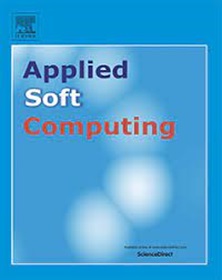ELSNC: A semi-supervised community detection method with integration of embedding-enhanced links and node content in attributed networks
IF 7.2
1区 计算机科学
Q1 COMPUTER SCIENCE, ARTIFICIAL INTELLIGENCE
引用次数: 0
Abstract
In complex network analysis, detecting communities is becoming increasingly important. However, it is difficult to fuse multiple types of information to enhance the community-detection performance in real-world applications. Besides the nodes and the edges, a network also contains the structure of communities, its networking topological structure, and the network embeddings. Note that existing works on community detection have limited usage of all these information types in combination. In this work, we designed a novel unified model called embedding-enhanced link-based semi-supervised community detection with node content (ELSNC). ELSNC integrates the structure of the topology, the priori information, the network embeddings, and the node content. First, we employ two non-negative matrix factorization (NMF)–based stochastic models to characterize the node-community membership and the content-community membership (by performing similarity detection between a topic model and the NMF). Second, we introduce the nodes’ and networking embeddings’ topological similarity into the model as topological information. To model the topological similarity, we introduce a strong constraint (i.e., the priori information) and apply matrix completion to identify the community membership with the network embeddings’ representation ability. Finally, we present a semi-supervised community-detection method based on NMF that combines the network topology, content information, and the network embeddings. Our work’s innovation can be captured in two points: 1) As a type of semi-supervised community detection method, we extend the theory of semi-supervised methods on attributed networks and propose a unified model that integrates multiple information types. 2) The community membership obtained by the unified model simultaneously contains different information, including the topological, content, priori, and embedding information, which can more robustly be explored in the community structure in real-world scenarios. Furthermore, we performed a comprehensive evaluation of our proposed approach compared with state-of-the-art methods on both synthetic and real-world networks. The results show that our proposed method significantly outperformed the baseline methods.
ELSNC:一种整合了属性网络中嵌入增强链接和节点内容的半监督社区检测方法
在复杂网络分析中,社群检测变得越来越重要。然而,在实际应用中,很难融合多种类型的信息来提高社群检测性能。除了节点和边,网络还包含社群结构、网络拓扑结构和网络嵌入。需要注意的是,现有的社群检测工作对所有这些信息类型的组合使用非常有限。在这项工作中,我们设计了一种新颖的统一模型,称为 "基于节点内容的嵌入增强链接半监督社区检测(ELSNC)"。ELSNC 整合了拓扑结构、先验信息、网络嵌入和节点内容。首先,我们采用两个基于非负矩阵因式分解(NMF)的随机模型来描述节点-社区成员身份和内容-社区成员身份(通过在主题模型和 NMF 之间进行相似性检测)。其次,我们将节点和网络嵌入的拓扑相似性作为拓扑信息引入模型。为了对拓扑相似性进行建模,我们引入了一个强约束条件(即先验信息),并应用矩阵补全来识别具有网络嵌入表示能力的社群成员。最后,我们提出了一种基于 NMF 的半监督社区检测方法,该方法结合了网络拓扑结构、内容信息和网络嵌入。我们的工作有两点创新:1) 作为一种半监督社区检测方法,我们扩展了归属网络半监督方法的理论,提出了一种整合多种信息类型的统一模型。2) 统一模型得到的社群成员信息同时包含拓扑信息、内容信息、先验信息和嵌入信息等不同信息,可以更稳健地探索真实世界场景中的社群结构。此外,我们还在合成网络和真实世界网络上对我们提出的方法与最先进的方法进行了综合评估。结果表明,我们提出的方法明显优于基线方法。
本文章由计算机程序翻译,如有差异,请以英文原文为准。
求助全文
约1分钟内获得全文
求助全文
来源期刊

Applied Soft Computing
工程技术-计算机:跨学科应用
CiteScore
15.80
自引率
6.90%
发文量
874
审稿时长
10.9 months
期刊介绍:
Applied Soft Computing is an international journal promoting an integrated view of soft computing to solve real life problems.The focus is to publish the highest quality research in application and convergence of the areas of Fuzzy Logic, Neural Networks, Evolutionary Computing, Rough Sets and other similar techniques to address real world complexities.
Applied Soft Computing is a rolling publication: articles are published as soon as the editor-in-chief has accepted them. Therefore, the web site will continuously be updated with new articles and the publication time will be short.
 求助内容:
求助内容: 应助结果提醒方式:
应助结果提醒方式:


